Gear List – 8.5lbs – 9lbs
Compared to the PCT, I carried ~1.5lbs+ more gear, mostly for warmth in adverse weather for the CDT. The average temperatures for me I think were higher than the PCT, especially night-time temperatures. Despite this, I carried an extra warmth layer, because of the frequency of afternoon thunderstorms. I also opted for a full length inflatable sleeping pad the entire trail instead of a torso foam as I have in the past. Something like the Gossamer Gear Nightlight is comfortable enough, but it takes up a lot of space in my pack, does not allow me to sleep on my hip comfortably when I’m trying to sleep facing away from the moon, and is more sensitive to lumpy campsites, which I was forced to use sometimes when setting up early because of storms rolling in for the night. Additionally, I carried a fanny pack the whole way for my camera and a compass; sleep socks, and a heavier battery pack.
For gear sizing and body-type reference, I am a cis male, 6’0ft, ~158lbs, 32″inseam, typically a Medium or Large for torso garments. I have a high metabolism, extremely high on the trail.
Pack – Pa’lante V2 Gridstop 19″ Torso (Currently Unavailable)
Weight after removing the hipbelt—14.9oz
Though I prefer the DCF version when packing up because of the stiffness, I prefer the minor stretch that the gridstop allows for comfort. The gridstop is also not waterproof, which I think is an advantage when it comes to Pa’lante, because they don’t seam tape their packs. When I had the DCF version on the Vermont Long Trail, it would rain all day, and I would have to periodically remove my pack and dump out the side pockets because the didn’t drain, and wouldn’t soak through the pack and out of the bottom. At the end of the day, there would be a puddle sitting at the bottom of the pack. There is better drainage with the gridstop despite there still not being drain holes on the sides.
I think I got unlucky with my pack, as I’m pretty sure they were experimenting with new mesh for the bottom and front shoulder strap pockets at the time. Compared to mine, a friend’s were much more robust. By the time I was out of Montana, both of my shoulder strap pockets were torn up enough that I could no longer keep small items in there like my head lamp, food, or chapstick, etc. I was able to continue using my phone for a while, and occasionally I would keep my camera in one, but I eventually cut the left one off when it was barely hanging on. There was one hole in the bottom pocket by the end. The rest of the pack held on just fine, with some pretty serious packing out of the shoulder straps.
I don’t think this is the most comfortable hipbeltless pack, but it has some features that feel essential, and I will probably continue to carry it. It’s also not the lightest in it’s class, and doesn’t pack the smallest. I think if they’d make it in a slightly lighter DCF, give it some drain holes, and add some padding to the shoulder straps, it be much improved. Lastly, I used one with a hipbelt, and though it did add some support when I had to haul a lot of water and food out of town (33 mile road walk out of Rawlins with 5 days of food), but by the time I was in New Mexico, I was tired of it popping out of the pack while using it so infrequently, so I cut it off.
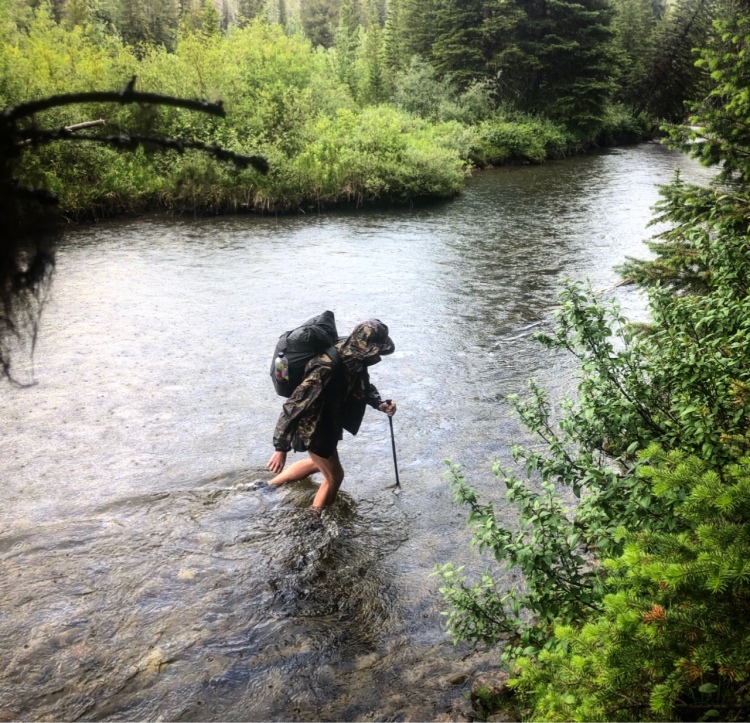
Katabatic Palisade and MLD Superlight Bivy DCF
Palisade 6’6″/Regular—19.25oz. MLD Bivy (Long)—5.5oz
This combination provided plenty of warmth for the entire trail. I had used the Superlight in the sil-nylon in the past, but did not like that water could bleed through when not using a groundsheet. The DCF is a bit lighter, and fully waterproof, which is better when not using a groundsheet, but I used a polycryo for most of this trail, because I wanted a place for my gear to rest out of the dirt. This also allowed me to pack my bivy dry, and my groundsheet wet, which ended up being important because of a faulty rain jacket (more on that later). The DCF packs a little bigger than the sil-nylon, but not by much. The sil also has a more “classic” UL feel, if you know what I mean.
The Palisade really fits me well, especially the toe box. I have a size 13 foot, and have what feels like a proper amount of space to move around in. The quilt is sized large for my height, but I like to tuck the excess around me on cold nights. That said, if I had it my way, I’d probably have a 6’3″ or 6’4″ quilt for the sake of shaving grams. I know Nunatak does this, but I know Katabatic works. If anyone is feeling generous, I would gladly accept the Katabatic 15 degree Sawatch in Regular/Long (6’6″) for winter and shoulder season use. Thanks.
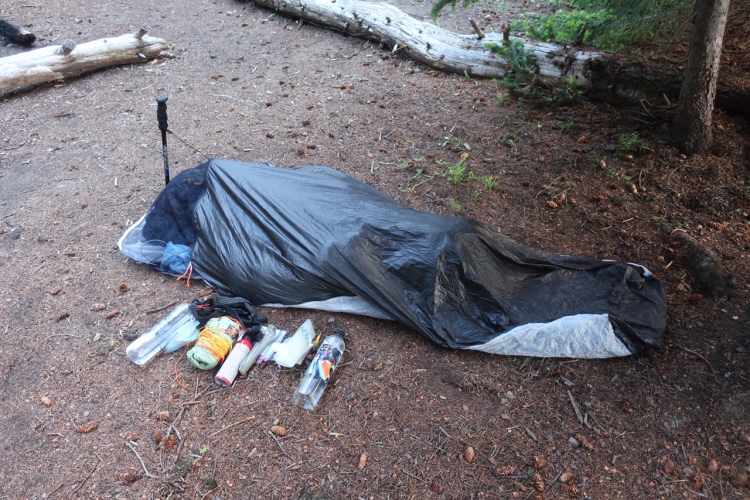
MLD Grace Solo / Z-Packs Hexamid Solo Plus / MLD Solomid XL (DCF)
So yeah, I have a closet full of DCF shelters. I used the Grace Solo until South Pass City. It was perfectly fine except for a few nights when I had the wind shift on me during storms and rain blowing in my open door. I never got wet, but I had some stressful moments. This shelter was the lightest of the three at 6.6 oz.
When I arrived at the Basin, I knew trees and good sticks would be in short supply, so I switched to my single pole Hexamid Solo Plus at 13.3oz. The bug netting was redundant with my bivy, but it’s all I had. Back in Darby, MT I had ordered a Solomid XL from MLD, but I knew I would be lucky to get it before the San Juans. The Hexamid was a little faster to set up, did not require me to sleep right next to a tree, or find a sturdy stick. It also provided full sided rain protection. One thing I don’t like is that in hard, prolonged rain, water that would drip straight down without the netting, would run down the netting, sometimes under my groundsheet, sometimes on top of it. This was especially the case during my last night in Colorado when the rain never stopped. The Solomid didn’t make it to me until Ghost Ranch, NM, around the time I no longer really needed it. I started carrying it anyway, as I wanted to practice with it for future harsh weather trips in alpine environments in the High Sierra, Wind River Range, and the Brook’s Range in Alaska.
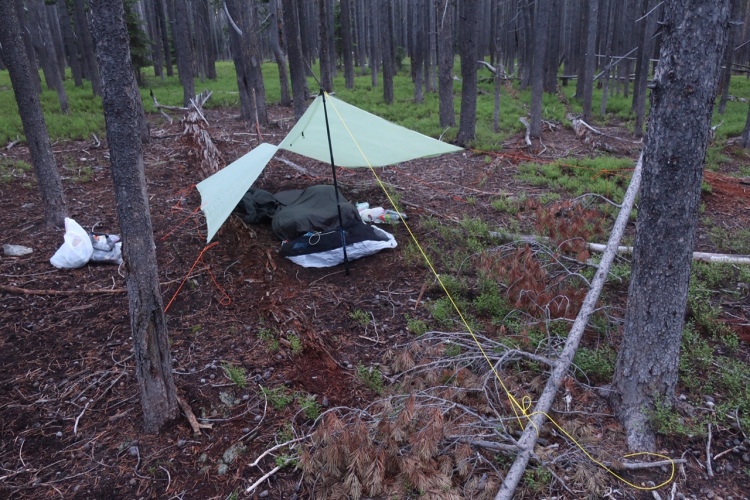
I was aware that the Solomid took some practice, and my first three or four pitches were pretty rough to look at, but it kept the rain out. I mostly cowboy camped through NM, but by the time I was done with the trail, I had more control over how high I was pitching it, and had the 4 sides pretty taught. Two really important factors seem to be getting your stakes in well, and squaring up the 4 main corner stakes. From there, it’s about tweaking. Also, though there is some weight to be shaved by removing them, keep the linelocs on. Makes things easier, and I imagine not having them in snow would be pretty rough. I hold onto shelter stuff sacks, because they keep other gear dry when the only part of the kit in the morning that’s wet is the shelter from rain the previous night. I used a Fizan Compact 3 trekking pole, and did not need to use the pole extender. You would want to bring it if you were doing a double pole inverted set up for more stability and interior space. That said, the shelter was solid with a single pole positioned vertically. Further than that, it will take some more time with the shelter before I can offer a thorough review. I will say that I have not felt more comfortable in any other shelter during a storm than I have in the Solomid XL.
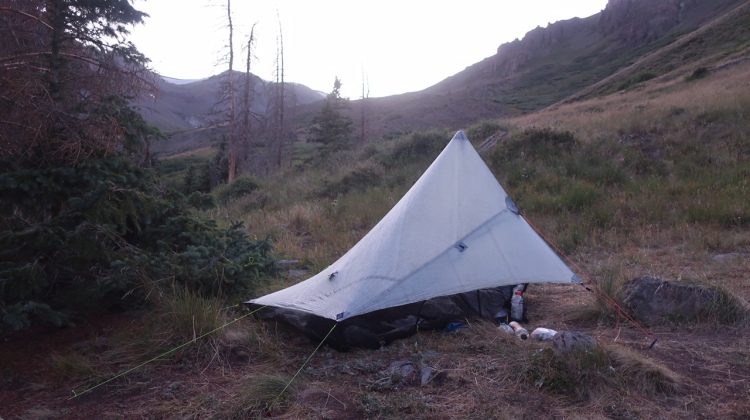
Solomid XL with 11 of 12 guylines with a mix of the yellow guyline MLD includes plus the 1.5mm pro for the panels = 13.4oz. The stuff sack is .6oz. The pole extender is .75oz.
If I were to hike the CDT again, I would want a Hexamid Solo Plus Tarp with a bug bivy until South Pass City. Then I’d switch to the Solomid XL and Superlight Bivy until the end, mostly for the cold wind in Colorado. It would be fine going back to the Hexamid for NM, but I’d probably just keep carrying the Solomid. I say a bug bivy instead of the Superlight with the Hexamid Tarp because I was often too warm up north, and there a couple of sections with serious mosquitos, namely Yellowstone, and some distance between them and me would have been more comfortable. I know some hikers that went through with just a bug headnet, or no headnet at all with a tarp, and may god rest their souls.
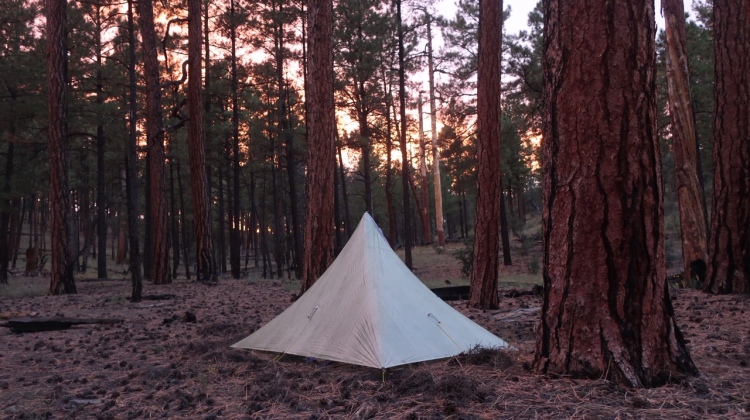
Topo Ultraventure – Size 13
Before these, I wore Hoka Challengers. The Topo’s resolved the recurring foot problems that I experienced in the Hoka’s. In the last year, Topo has switched to proper Vibram outsoles for their Terraventure and Ultraventure models, and bravo. They lasted much longer than the full foam Hoka’s. The Ultraventure is similar in cushioning to something like the Altra Timps, but with a better, longer-lasting outsole and mid-sole. They retain the footshape toe box, but are more trim in the mid foot than Altra. More secure feel with the restriction at the toe box. They Ultraventures also have a 5mm drop, which I like. One of the cons that I experienced was on the first and second pair, there was some pre-mature separation at the arch with the midsole from the upper, but did not happen with the remainder of my pairs. Maybe Topo switched the glue? One more con was that though I found the Ortholite insole a step up from most stock insoles in terms of comfort and durability, it really soaked up water.
I will continue to use the Ultraventures, but I am experimenting now with the less-cushioned but rock-plated (Ultras have no rock plate) Terraventure 2’s. So far so good. I’d like to walk a little lower to the ground for some high routes I have planned, and would appreciate the rock plate protection. My feet have changed over the last 6,000 miles, and need different things as I go on.
Neo-air X-Lite (R)
After I adjusted to sleeping on the trail the first week, I probably averaged 7 hours of sleep the rest of the trail, often un-interrupted sleep (until it began leaking) when I managed not to drink too much water before bed. In other words, the pad was good to me. Mine weighs 11.9oz, and feels worth carrying. This pad corrected for a lot of lumpy camp sites.
Around southern Wyoming, the pad began to leak slowly. I couldn’t find a hole, and didn’t worry too much about it. In northern CO it got bad enough that I had to either find a fix a hole, or buy a new one. So I bought a new one in Dillon, CO, but ended up getting a motel room, and found a hole in my old one. I patched it, and it no longer leaked, so I returned the new one. About two weeks later, another slow leak. I dealt with it until NM, when I found a hole in the top of the pad in Grants, NM. I patched it, and it stopped the leak. A few days later, leaking again. I’m just about over it at this point, an am eye-balling my GG Nightlight again, maybe packing a short 1/8″ pad for my legs, because it really is not fun dealing with a wet backpack inside an inside-out pack liner at the end of a long day as leg insulation.
Quarter Zip 100wt Fleece (M) / Melly Microgrid (M)
I didn’t start the CDT with a fleece, but after my last day in Glacier in some slow, steady rain, I had trouble staying warm enough with just the wind shell after I got wet. I knew there were going to be daily storms in The Bob, so I found a simple quarter zip fleece in a general store in Glacier. It worked great, and though I could have gotten by in the mornings with just a wind shell, adding a fleece sure made things more comfortable. It also level-up’d my pillow game when stuffed inside my Borah Jacket.
The zipper broke on my fleece about a week before Leadville, so I had a good enough excuse to buy a Melly while I was there. My medium weighs 10.2oz, marginally heavier when considering that it has a hood. If it was too hot to climb with it, I just wore a wind shell opened up instead. There’s nothing special about this garment, but it is really comfortable, and a great sleep layer if it’s cold enough out, but it hardly was. It was mostly a pillow at night, a morning hiking layer, and a rain buffer.
Lightheart Gear Sil-Poly Rain Jacket (M)
I think it’s dangerous to call this a rain jacket. Lightheart Gear claims that they don’t need to tape the seams because they’re bonded. After freezing through several storms in this thing, I’m confident in saying that this is not the case. Water came in through the storm flap up front, all of the seams, and through the pit zips. After just 10 minutes during any storm, I was soaked and getting colder every minute. It was bad enough that had I not had a tarp or groundsheet with me to wrap around me like a cape, I would have had to repeatedly stop hiking extremely early or risk hypothermia. I should have just picked up a Frogg Toggs or shelled out for something new. In New Mexico, I thought I was going to make it to an awning to stand under before this isolated storm hit me. I had put on my rain jacket already but was trying to avoid using my groundsheet as a cape so that I wouldn’t have to dry it out after. The storm got me. While this was the kind of rain that forces cars to pull off the interstate, I thought I’d have enough time to get out my “cape” in time. After maybe 10 seconds, I was completely soaked through. I stood under the awning holding my rain jacket out in the wind, and allowed my my hiking shirt to dry while the storm blew over.
One thing to note, I used all of my tenacious tape and duct tape I had to seal some of the seams. It helped, but didn’t resolve everything. You could probably seal most of the failure points yourself, but at that point, it’s going to be heavier than a lot of jackets out there.
I might experiment with the external membrane jackets going forward. Until I decide to pay for one of those, I’ll probably use an old DWR jacket with an umbrella.
Borah Gear Puffy Jacket (M)
This wasn’t a critical piece of gear, but it made for a great pillow case and morning layer while I was packing up. I’ve washed this jacket once over 6,000 miles with it, and it’s working with no zipper or down leakage issues. It’s boxy, but I’m kind of into that “DIY” look when it comes to a puffy.
Sunto M-3G
The gold standard non-mirrored compass. Solid if you have maps that are in the appropriate scale.
Nitecore NU-25 w/Backcountry Banter Headband
I charged it every three nights or so as a precaution to keep it from going out. Plenty bright, light, and compact. I carried a handheld LD02 on the PCT, and Black Diamond Spot on the Long Trail (lots of time in the dark in the fog). Out of the three, I prefer the NU 25 for average daylight and low fog conditions. I don’t think it would be enough for something like the Long Trail late in the season, but it rocked the CDT.
As of today, Joe is still on the Appalachian Trail, and is not processing orders. They’re worth picking up if you can get one though. He makes them tailored to the size of your head.
Montbell Chameece Fleece Gloves (L)
Warm enough most of the time. When they weren’t warm enough, usually between 6-7am, I just put my hands in my shorts, or in my Melly kangaroo pocket.
Showa 281 Gloves (XL)
My hands were usually the only thing dry during storms, because of these. I prefer these unlined ones under fleece liners rather than the lined 282’s. They have a long cuff, and tuck well under rain jacket sleeves for a proper seal.
Patagonia Sun Stretch L/S (M)
I used another one of these on the PCT. They’re great. It’s a nylon/poly blend with double layer fabric at the shoulders (fishing shirt style), and two chest pockets with a secure, low profile side zipper. I used just one shirt for the whole trail, and it still isn’t stained, torn, has no loose threads, and the zippers are still going. It’s not a cheap shirt at $100, but it will go the distance. Patagonia markets it as being specifically for “hot and humid conditions,” and I would agree that it excels there. I use a short sleeve version for the east coast.
Aquamira
Aquamira or bust. I know people who had Sawyers crack or freeze. I’ve used Aquamira with repacked bottles, plus a pre-mix, on all of my long hikes. It’s important not to run out of course, and this system works best if you’re sending yourself some boxes at least every once in a while. There’s a lot of cows and some sheep on this trail, and I almost always treated my water. I kept the pre-mix in my shirt pocket for convenience, put the drops in at the source, and was on my way. Aquamira is the biggest advantage when you’re carrying out three or four liters. I would blow my top by the fourth liter if I had to squeeze the water through a membrane filter.
What I would Change
I’ve mentioned a few things, but I would probably take a rain skirt until New Mexico. Walking through cold brush sucks. If you don’t want to carry a ground sheet under your bivy, it also makes for a great gear mat. You can also retrofit some as a tarp door.
I would try a different rain jacket. I carried an umbrella for a while, but it wasn’t worth it. More trouble to keep up with than it was worth to me.
I would entertain using a foam pad again for ease of use.
I might carry a different frameless pack for more comfort, but I’d miss the bottom pocket.